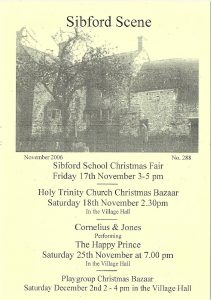I Remember
On November the eleventh my mind goes back seventy years to the Armistice Day service in the middle thirties in my school assembly hall in Banbury where a wreath was laid on the war memorial with its plaque in memory of about four dozen former pupils who lost their lives in the Great War. Little did we think that ten years later there would be a second plaque with over forty more names of pupils who died in an even longer World War which included a large number of that congregation and several of my classmates, including Peter Erikson who sat at the desk behind mine and Leslie Tyrrell from the one in front. His birthday was the day before mine, a fact of which I had an annual reminder by an in memorium notice in the Banbury Guardian each year at that time. I left school in 1938, but those who stayed on for their Higher School Certificates would have left in the summer of 1940 at 17 or 18 years of age and many chose to go straight into the RAF as pilots or aircrew rather than wait for their call-up and be drafted into the Army.
In Sibford I think Arch Kaye was the first loss in WW2. Arch was a pre-war regular army soldier. At that time their kitchen garden adjoined ours on the Hook Norton road before their move to Epwell and as a child I used to think how smart he looked in his uniform with white lanyard etc. That was before the days of the (dare I say it?) ‘hairy-Mary’ battledress which we wore in the army and prior to that in the Home Guard. I also wore the RAF blue version in the Royal Observer Corps in the Cold War. Arch lost his life at Dunkirk and we heard later that he had been seen boarding a troop ship which may well have been the ill-fated Lancastria. She was hit three times by dive bombers while lying fully loaded awaiting a destroyer escort. She capsized with thousands on board. Estimates I have seen vary from 2,500 to 6,000. The loss of life must have been on a par with that in the Twin Towers of 9/11 but the news of the sinking was hushed up when Churchill said he thought the British people had had enough bad news for one day.
I also remember Bob Freeman of Epwell who was in Mr. Hooper’s classroom at Sibford Gower School when I moved into it. He lost his life on a bombing raid over Germany.
I remember the Wellington bomber which crashed in the fields across the road from Little London while doing ‘circuits and bumps’ on a quiet night when the weather suddenly changed. Sadly it was only one of many which met the same fate that night.
After my Army call up in June 1943 and Royal Signals trade training, I was posted just before Christmas to the 79th Armoured Division in Suffolk and was attached to the 22nd Dragoons, a flail tank regiment. They were being trained to flail paths through the minefields on the D. Day beaches. They had a motley collection of tanks and vehicles but when mobilisation started these were replaced with brand new Sherman flails, Austin lorries etc. We all had booster jabs for the three T’s, typhoid, tetanus and typhus and we all made our wills which were handed in. Then we moved to Sussex where we were based at Petworth House with the troops of tanks in the surrounding countryside. Shortly before D. Day they gathered for an inspection by a V.I.P. who turned out to be H.M. King George VI.
Everybody was given a 24hr leave pass and travel warrant for home leave and on our return Petworth House was sealed and D. Day briefing of the tank crews began. I thought of the lines of the hymn we used to sing on Armistice Day. “Proudly they gathered, rank on rank to war”. There was some talk of the 50% casualty rate that they had been warned to expect on D. Day but mostly they kept off that subject. A and B squadrons were selected to go on D. Day with C squadron to stay in reserve to supply trained replacements. They all had an invasion haircut which left them almost bald and left in good spirits to be re-united with their tanks on the invasion ships.
They were destined to land on Juno Beach to flail paths for the Canadian Army. Thankfully the regiment’s casualties were not as heavy as had been feared and it was some months before the 50% total was passed, a figure which included 60 dead and almost 300 wounded by the end of hostilities.
While I was serving in Normandy I received a letter from my father with the shattering news that my mother’s sisters Ella and Nora met up in London with their brother Len, when a doodlebug fell, killing all three! Nora, the youngest had already lost her husband, a naval reservist, when his ship was sunk while escorting an Atlantic convoy.
For our tomorrow they gave their today.
Bob Lamb
